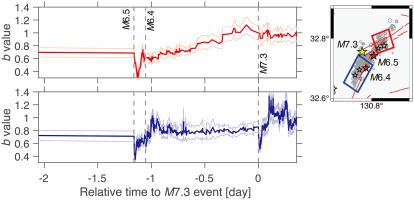Tectonophysics ( IF 2.7 ) Pub Date : 2021-12-06 , DOI: 10.1016/j.tecto.2021.229175 K.Z. Nanjo 1, 2, 3 , J. Izutsu 4 , Y. Orihara 5 , M. Kamogawa 1

|
Crustal deformation due to the 2016 earthquake sequence in Kumamoto, Japan, that culminated in a preceding earthquake of magnitude M6.5 and a subsequent M7.3 earthquake 28 h later, caused stress perturbation on and around the causative Futagawa-Hinagu fault zone. Monitoring changes in seismicity pattern along this zone plays a role in understanding the process before and after major earthquakes. For this purpose, stress-dependent laws in statistical seismology can be used: the Gutenberg-Richter frequency-size law and the Omori-Utsu aftershock-decay law. We review the results obtained by using these laws in previous studies to show a zone of high stress near the eventual epicenters of the M6.5 and M7.3 earthquakes before the start of the Kumamoto sequence, and after it, showing a decreasing trend in stress along the Futagawa-Hinagu fault zone. Detailed analysis suggests aseismic slips along the causative fault zone. The aseismic preslip locally reduced stress just prior to the M7.3 earthquake near its epicenter. Recently, a system was proposed by Gulia and Wiemer (2019) that utilizes the Gutenberg-Richter frequency-size law to judge, immediately after a large earthquake, whether it was the mainshock or a foreshock to a future event. Based on the reviewed results and our new results, further research that takes into account the spatial variation of frequency-size distribution, allowing the exploration of the possibility of a local preslip of a future nearby earthquake, is needed to improve this system.
中文翻译:

2016 年熊本地震序列引起的地震活动模式变化及其对改进前震交通信号灯系统的影响
地壳变形由于在熊本,日本2016年地震序列,其最终导致幅度的地震前在中号6.5和随后的中号7.3地震28小时后,造成应力扰动上和周围的致病二川-Hinagu断裂带。监测该带地震活动模式的变化对于了解大地震前后的过程起着重要作用。为此,可以使用统计地震学中的应力相关定律:Gutenberg-Richter 频率大小定律和 Omori-Utsu 余震衰变定律。我们回顾了在以前的研究中使用这些定律获得的结果,以显示M 6.5 和M的最终震中附近的高应力区域熊本层序开始前后的 7.3 次地震沿二川-日奈古断裂带应力呈递减趋势。详细分析表明,沿成因断层带发生了地震滑动。就在震中附近的M 7.3 地震发生之前,抗震前滑动局部降低了应力。最近,Gulia 和 Wiemer (2019) 提出了一个系统,该系统利用 Gutenberg-Richter 频率大小定律在大地震发生后立即判断是主震还是未来事件的前震。基于回顾的结果和我们的新结果,需要进一步研究考虑频率大小分布的空间变化,从而探索未来附近地震发生局部预滑的可能性,以改进该系统。


















































 京公网安备 11010802027423号
京公网安备 11010802027423号